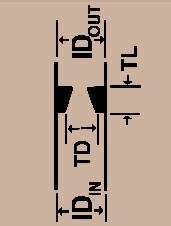Following is a picture of an anti-surge device I.e Air Chamber

In transient times water can be pushed out of chamber to avoid column separation while high pressure peaks can be cushioned by air volume trapped.
For the flow of water out of chamber I have Cd-A while for flow into the chamber I have Cd-B. Because of the same bore naturally Cd-A = Cd-B
My question now is: Can I have an orifice (or any other arrangement) at the arrowed location such that my objective is met which is Cd-A > Cd-B

In transient times water can be pushed out of chamber to avoid column separation while high pressure peaks can be cushioned by air volume trapped.
For the flow of water out of chamber I have Cd-A while for flow into the chamber I have Cd-B. Because of the same bore naturally Cd-A = Cd-B
My question now is: Can I have an orifice (or any other arrangement) at the arrowed location such that my objective is met which is Cd-A > Cd-B


